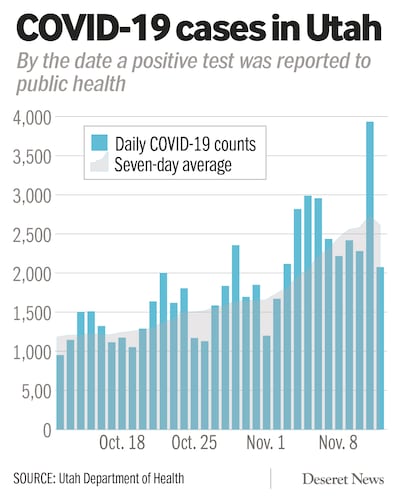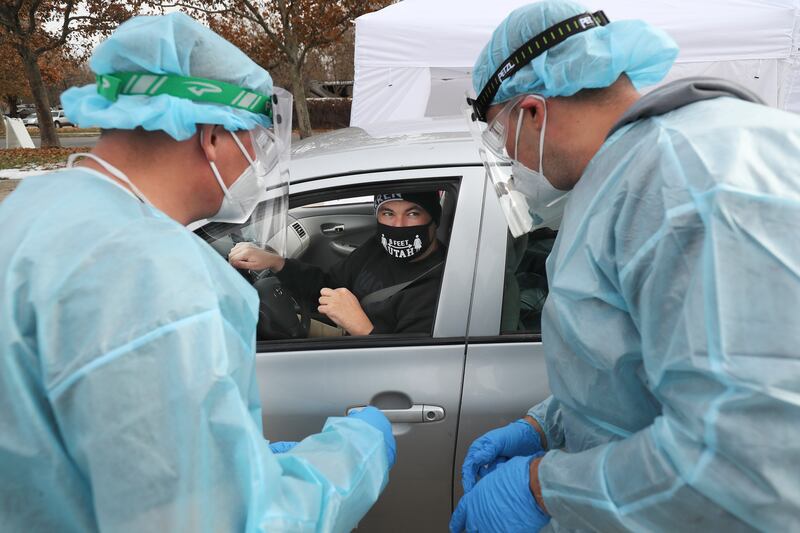SALT LAKE CITY — Utah’s deaths due to COVID-19 surpassed 700 on Friday as 14 more were reported, and hospitalizations with the disease reached an all-time high in the state.
Utah health officials also confirmed another 2,150 new COVID-19 cases out of 12,157 people tested, with a 12.5% positive rate. The rolling seven-day average for positive tests is now 2,616 per day, and the average positive test rate is 23.5%.
Friday’s reported case and testing counts, however, were incomplete and “artificially low” due to “significant technical difficulties” with the Utah Department of Health’s data system, officials said. The cases and tests left out of Friday’s report will be added to Saturday’s report, meaning the day’s case and test count will appear artificially high.
The latest data on deaths and hospitalizations was not impacted by the technical difficulties, according to the state health department. Currently, 473 patients are hospitalized with the disease in Utah, which is five more than were hospitalized on Thursday.
The Beehive State’s intensive care units were 84.7% full overall, but referral ICUs that can treat the most serious coronavirus patients were 87% full, according to the Utah Department of Health.
As infection rates continue climbing in the state, so does demand for testing, with some residents reporting waits of a day or more to get a testing appointment.

Officials encourage those with symptoms to call different testing sites, which can be found at coronavirus.utah.gov/utah-covid-19-testing-locations, to locate one with availability.
“People shouldn’t give up if they can’t find a testing location, just be willing to call around,” said Joe Dougherty, spokesman with the Utah Division of Emergency Management.
“It’s OK to look around and find other locations. Maybe the one closest to you may not be the most convenient one,” he said.
The state, meanwhile, is working to provide more accurate information about where tests are available on any given day, according to Dougherty.
While PCR tests remain the most common in Utah, rapid antigen testing of asymptomatic individuals is increasingly being viewed as key to fighting the surge — and state officials are working to bring more of those testing supplies to the state.
Utah’s current testing capacity remains between 20,000 and 30,000 a day, not including rapid antigen tests that will be distributed to students as Utah undergoes a massive effort to help universities and technical colleges implement weekly testing.

Gov. Gary Herbert’s most recent public health order requires everyone in the Utah System of Higher Education who lives on campus or attends at least one class in person per week to get a weekly test. Colleges are required to implement the testing no later than Jan. 1.
The system includes 230,000 students total — but officials are working to tally how many actually live on campus or attend in-person classes, according to a spokeswoman with the Utah System of Higher Education.
The state decided to target its college population at the suggestion of White House Coronavirus Task Force coordinator Dr. Deborah Birx, and Dr. Robert Redfield, director of the Centers for Disease Control and Prevention.
Those ages 15-24 account for a large proportion of the state’s confirmed cases, according to health department data. Many are also likely to be asymptomatic and spread the disease without knowing it.
Nearly 1 million rapid antigen tests had been promised to the state from the federal government before state officials met with Birx and Redfield, but Utah officials asked for more in order to implement asymptomatic testing among college students, Dougherty said.
Antigen tests are less taxing on state resources as they don’t need to be processed in a lab. Samples are taken by a less invasive nasal swab method than those taken for PCR tests, but they require someone with a specific certification from the Centers for Medicare & Medicaid Services to administer the test to ensure integrity is retained in the sample.
The state is expecting 100,000 of those tests manufactured by Abbott within the coming week, he said, followed by another 125,000 tests. The Abbott tests cost $5, but other rapid antigen test prices vary. The federal government is sending the tests to Utah at no cost to the state.
By the end of next week, the state will have sent 100,000 of those tests to colleges and universities. Many schools, meanwhile, are also purchasing tests on their own to fulfill the tall order.
But officials don’t know how long Utah will continue receiving antigen tests from the federal government, as many other states are also seeing surges and likely requesting supplies. State officials continue working on plans to continue testing asymptomatic students and eventually anyone who would like a test, Dougherty said.

New deaths
The deaths reported Friday bring the state’s toll to 701. They included six Salt Lake County residents: two men between 25 and 44 and two women between 65 and 84, all of whom were hospitalized when they died; and two men between 65 and 84, one of whom was a long-term care resident, and one who was not hospitalized when he died.
Two Morgan County men also died — one of whom was older than 85 and hospitalized when he died, and the other between 65 and 84 and not hospitalized. The fatalities also included two Box Elder County women — a long-term care resident between 45 and 64, and a woman older than 85, who was not hospitalized.
A Weber County man and Washington County man, both between 65 and 84, also died while hospitalized, as well as a Davis County man between 45 and 64. A Utah County woman between 45 and 64 died without hospitalization.
New COVID-19 cases reported Friday by health district:
- Salt Lake County, 814
- Utah County, 492
- Davis County, 290
- Weber-Morgan, 165
- Southwest Utah, 122
- Bear River, 107
- Central Utah, 47
- Tooele County, 42
- Southeast Utah, 21
- TriCounty (Uinta Basin), 19
- Summit County, 16
- Wasatch County, 13
- San Juan County, 2


